Creating the Perfect Bonsai Garden Sanctuary: Essential Planning Tips
To create a truly remarkable bonsai garden sanctuary, you’ll need to approach planning with both creativity and practicality. Start by assessing your available space—whether it’s a dedicated corner of your yard, a balcony, or a special indoor area—and determine how many bonsai trees you can reasonably maintain. Consider sun exposure patterns throughout the day, as most bonsai require at least 4-6 hours of sunlight. Design your layout with varying heights using benches, stands, or natural elevation changes to create visual interest and proper viewing angles for each tree. Incorporate complementary elements like small rocks, moss, and miniature accessories to enhance the atmosphere while maintaining proportion. Plan for seasonal changes by creating flexible spaces that can showcase different trees as they reach their peak beauty throughout the year. Remember to include convenient access to water sources and storage for essential tools nearby to make maintenance efficient. Your bonsai sanctuary should feel like a cohesive, intentional space that invites contemplation while showcasing your living art collection in its best light.
Choosing the Ideal Location for Your Bonsai Garden

Finding the perfect spot for your bonsai garden is crucial for the health and beauty of your miniature trees. The right location affects everything from growth rate to maintenance requirements.
Indoor Bonsai Garden Considerations
When creating an indoor bonsai garden, light exposure is your primary concern. Position your display near south-facing windows for maximum natural light, as most indoor bonsai species need 5-6 hours of bright, indirect sunlight daily. Consider humidity levels too—many indoor varieties like Ficus, Jade, and Chinese Elm thrive in environments with 40-60% humidity. You’ll want to keep your bonsai away from heating vents, air conditioners, and drafty areas that cause temperature fluctuations. A dedicated shelf, table, or cabinet at eye level not only showcases your collection beautifully but also prevents accidental bumping. Remember that different rooms offer varying microclimates—kitchens and bathrooms typically provide higher humidity, while living rooms might offer better light conditions.
Outdoor Bonsai Garden Requirements
Outdoor bonsai gardens require strategic placement to balance sunlight exposure with protection from harsh elements. Most outdoor bonsai species like Junipers, Pines, and Maples need 4-6 hours of morning sun followed by afternoon shade, especially in hot climates. Wind protection is essential—strong gusts can damage delicate branches and accelerate soil drying. Consider elevated platforms or benches (18-36 inches high) to improve viewing angles and protect trees from ground pests. Your garden’s microclimate matters significantly—areas against south-facing walls retain heat, while spots under tall trees provide dappled shade. For year-round displays, plan for seasonal adjustments—tropical species may need to come indoors during winter months in colder regions. Finally, ensure your outdoor bonsai garden has convenient access to water sources and is visible from indoor living spaces so you can enjoy your living art collection throughout the year.
10 Stunning Bonsai Display Methods to Showcase Your Collection
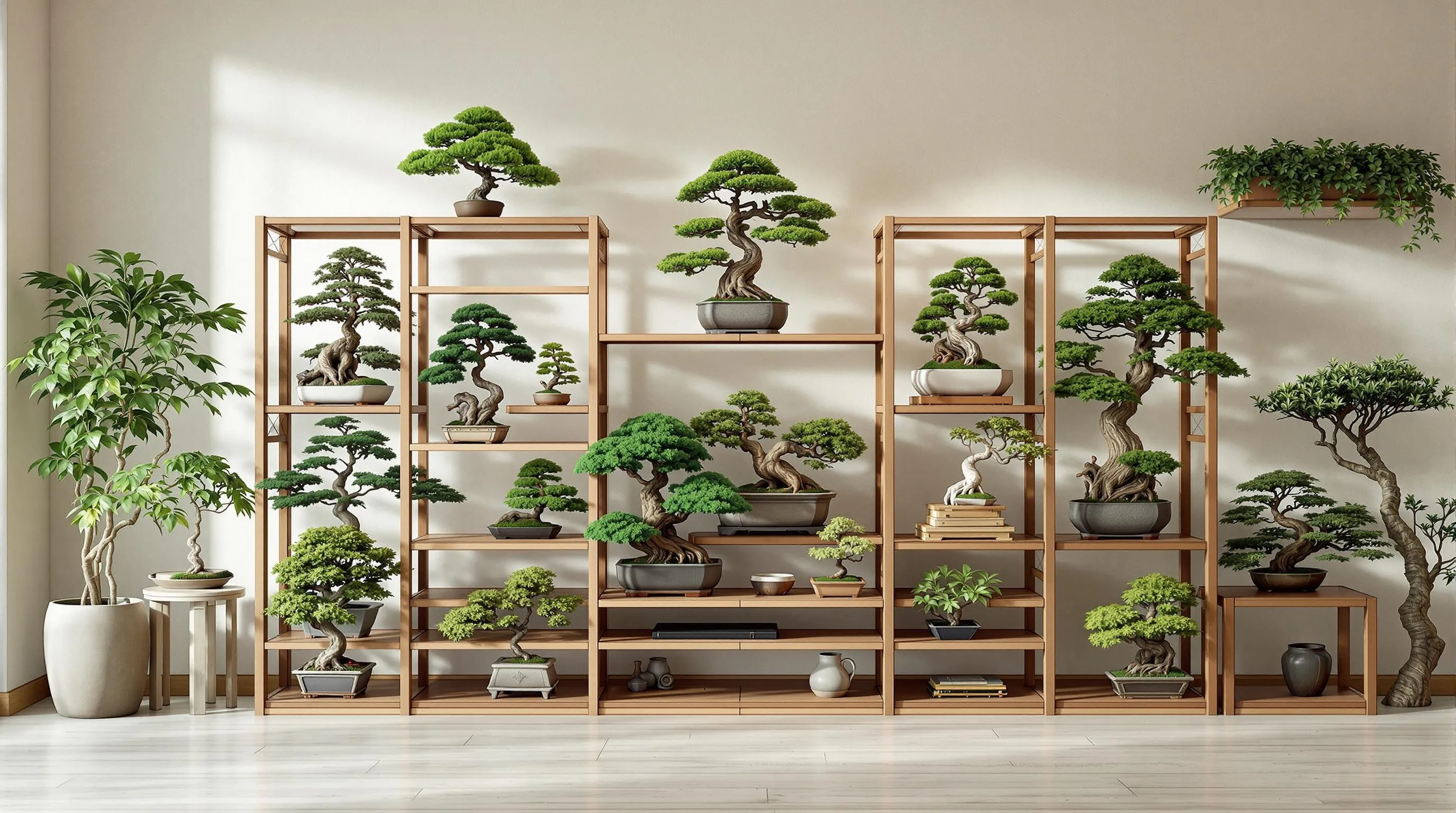
The way you display your bonsai collection can enhance their beauty and create a more impactful visual experience. Here are ten display methods that will elevate your bonsai presentation.
Multi-Level Shelving Arrangements
Multi-level shelving transforms your bonsai collection into a ever-changing vertical garden that maximizes space while creating visual interest. Opt for sturdy wooden or bamboo shelving units with varying heights to showcase trees of different sizes and styles. Position taller specimens on lower shelves and smaller ones at eye level to ensure proper viewing angles for each tree. This arrangement allows visitors to appreciate the unique characteristics of each bonsai without crowding, while also creating depth through layering. For optimal aesthetics, alternate the positioning of trees on each level and leave adequate space between specimens to prevent overcrowding and ensure proper air circulation for healthier trees.
Japanese-Inspired Display Tables
Traditional Japanese display tables, known as “tokonoma” or “shohin” stands, offer an elegant and authentic way to showcase your prized bonsai. These tables typically feature clean lines, natural wood finishes, and subtle craftsmanship that complement rather than compete with your trees. Select tables with heights between 30-36 inches to position your bonsai at optimal viewing level. For formal displays, consider using a plain dark wood stand to highlight a single specimen tree with a complementary accent plant or scroll. The minimalist design of these tables draws attention to the bonsai’s intricate details while honoring the Japanese aesthetic principles of simplicity and harmony. Many enthusiasts use these stands for seasonal rotations, displaying different trees throughout the year to celebrate their changing beauty.
Outdoor Bench Presentations
Outdoor benches provide a practical and attractive way to display bonsai in your garden space. Choose weather-resistant materials like cedar, teak, or concrete that can withstand the elements while complementing your outdoor aesthetic. Arrange your benches at varying heights (18-30 inches) to create visual interest and ensure proper viewing angles for each specimen. Position your collection strategically to balance sun exposure with protection from harsh elements, considering each species’ exact light requirements. This display method allows you to integrate your bonsai with the surrounding industry while keeping them elevated from ground-level pests and making maintenance more accessible. For enhanced visual appeal, group trees with similar styles or complementary seasonal features on the same bench.
Rotating Seasonal Display Areas
Seasonal rotation displays celebrate your bonsai collection’s changing beauty throughout the year. Create dedicated areas in your garden or home where you can showcase trees at their peak seasonal interest—flowering cherries in spring, maples with vibrant autumn colors, or pines with fresh candles in summer. Design each area with complementary background elements that enhance the seasonal theme, such as spring bulbs, autumn leaves, or winter berries. This display method not only highlights each tree’s best features but also creates fresh visual experiences as the seasons change. Carry out a simple calendar system to track which specimens should be featured during each season, ensuring your collection remains ever-changing and captivating year-round.
Spotlight Alcove Arrangements
Alcove arrangements create dramatic focal points that highlight your most impressive bonsai specimens. Design recessed areas in walls or freestanding dividers with adjustable spotlight lighting to emphasize the trees’ unique characteristics and cast artistic shadows. Select a neutral background color that contrasts with your bonsai’s foliage—light colors for dark foliage and vice versa. Position each tree at eye level (approximately 48-60 inches from the floor) for optimal viewing and consider adding a small accent plant or suiseki stone for balanced composition. This display method draws inspiration from the Japanese tokonoma tradition while adding contemporary lighting techniques to create a gallery-like presentation that transforms your bonsai into living sculptures.
Glass Cabinet Environments
Glass cabinets offer protection for delicate or tropical bonsai while creating controlled display environments. Select cabinets with adjustable glass shelving and built-in lighting systems to showcase multiple specimens while maintaining proper humidity levels. Install small digital hygrometers to monitor conditions and consider incorporating tiny fans for air circulation if displaying tropical varieties. This method is particularly effective for indoor displays of moisture-loving species like ficus or Chinese elms, protecting them from dry heating systems while keeping curious pets at bay. Position your cabinet away from direct sunlight and heat sources to maintain stable growing conditions while providing an elegant, museum-quality presentation for your most valuable specimens.
Rustic Natural Stone Platforms
Natural stone platforms bring an organic, weathered aesthetic to your bonsai display that enhances their connection to the industry. Select flat stones like slate, granite, or limestone with interesting textures and colors that complement your bonsai containers without overwhelming them. Create stable, level platforms by stacking stones of varying heights (12-24 inches) and securing them with concealed landscaping adhesive. This display method works exceptionally well in garden settings where the stones blend with the surroundings while elevating your bonsai to viewing height. For enhanced natural appeal, allow moss or small alpine plants to grow between the stones, creating a seamless transition between the display and your garden environment.
Wall-Mounted Display Systems
Wall-mounted displays make brilliant use of vertical space in smaller gardens or apartments. Install sturdy metal or wooden brackets designed to support the weight of potted bonsai, ensuring they’re anchored securely to wall studs. Arrange your display in an asymmetrical pattern with varying heights to create visual interest and prevent a rigid, uniform appearance. This method is particularly effective for cascade and semi-cascade style bonsai whose dramatic forms are emphasized when viewed against a wall. Consider painting the wall behind your display in a complementary neutral tone that makes your trees’ silhouettes stand out dramatically. Remember to position your wall display away from heating vents and in locations that receive appropriate light for your exact tree species.
Miniature Industry Integration
Miniature industry integration embeds your bonsai within scaled garden vignettes that tell a visual story. Create small industry scenes using appropriately sized elements like pebble “streams,” miniature bridges, or tiny moss “meadows” surrounding your bonsai. Scale all elements proportionally to maintain the illusion of a mature tree in a natural setting. This display method is particularly effective for larger bonsai gardens where visitors can view the scenes from multiple angles. For enhanced realism, consider seasonal changes in your miniature landscapes, adding tiny fall foliage or spring “flowers” that complement your bonsai’s seasonal changes, creating an immersive viewing experience that transports visitors to a miniaturized natural industry.
Floating Shelf Arrangements
Floating shelves create a contemporary, space-efficient display that makes your bonsai appear to hover elegantly against a wall. Install heavy-duty floating shelves capable of supporting the weight of potted trees (typically rated for at least 30-50 pounds per shelf). Arrange shelves at varying heights, allowing 18-24 inches between levels to accommodate different tree sizes and styles. This minimalist display method works particularly well in modern interiors where clean lines complement the organic forms of your bonsai. Position shelves where each tree receives appropriate light for its species while ensuring the display is visible from your primary seating areas. For added visual impact, install subtle LED strip lighting beneath each shelf to illuminate the trees from below, highlighting their branch structure and creating dramatic shadows.
Designing a Zen-Inspired Bonsai Garden Retreat
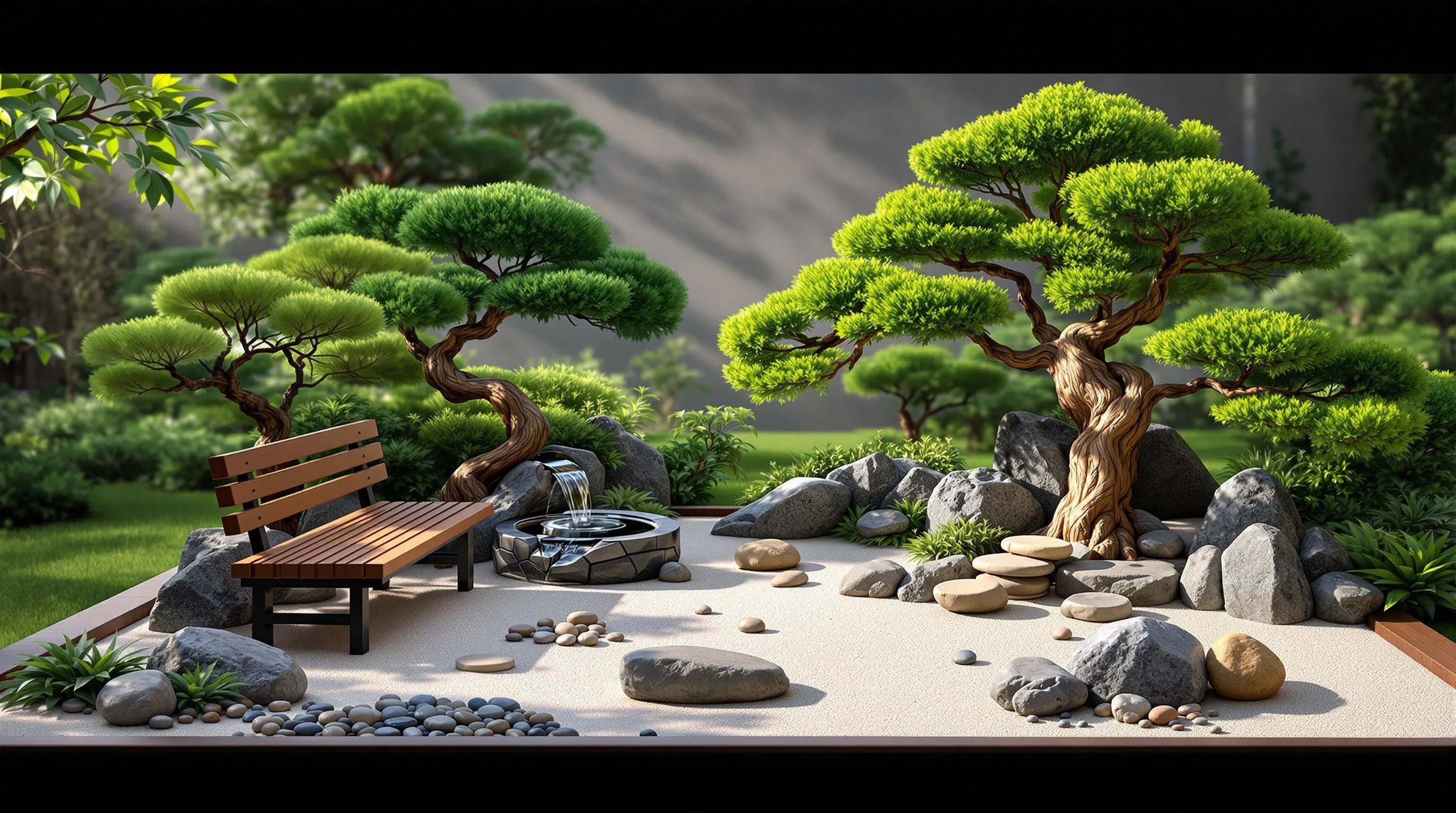
A Zen-inspired bonsai garden transforms your space into a personal sanctuary where nature’s miniature beauty meets mindful design. By thoughtfully blending traditional Japanese aesthetic principles with your personal style, you’ll create a peaceful retreat that invites contemplation and serenity.
Incorporating Natural Elements Like Stone and Water
Natural elements are essential foundations of any authentic Zen bonsai garden. Incorporate carefully selected stones—choose weathered rocks with interesting textures and varying sizes to create miniature landscapes that mimic mountains or islands. Position larger stones partially buried to appear as if they’ve been there for centuries. Water features add both visual appeal and soothing sounds—consider a small bubbling fountain, a shallow pebble basin, or even a miniature dry riverbed using fine gravel raked in gentle patterns. These elements create what Japanese gardeners call “borrowed scenery,” where your small space evokes the feeling of vast natural landscapes. Add fine white sand or small pebbles to create negative space between your bonsai displays, allowing each tree’s unique character to stand out while contributing to the garden’s overall harmony.
Creating Meditation Spaces Among Your Bonsai
Designate a dedicated seating area within your bonsai garden where you can sit quietly and absorb the tranquility. A simple wooden bench, flat stone, or even a comfortable cushion positioned strategically provides the perfect vantage point to appreciate your living art collection. Arrange your most visually striking bonsai specimens where they can be clearly viewed from this meditation space, considering how light falls across their forms throughout the day. Enhance the meditative atmosphere with subtle elements like a small Buddha statue, a traditional stone lantern, or wind chimes that create gentle, mindful sounds. Leave adequate open space around your meditation area—emptiness is just as important as the physical elements in Zen design, allowing the mind to settle and appreciate the beauty in simplicity. This thoughtful balance between presence and absence creates a retreat that nurtures both your bonsai collection and your inner calm.
Seasonal Bonsai Garden Arrangements to Maintain Year-Round Beauty
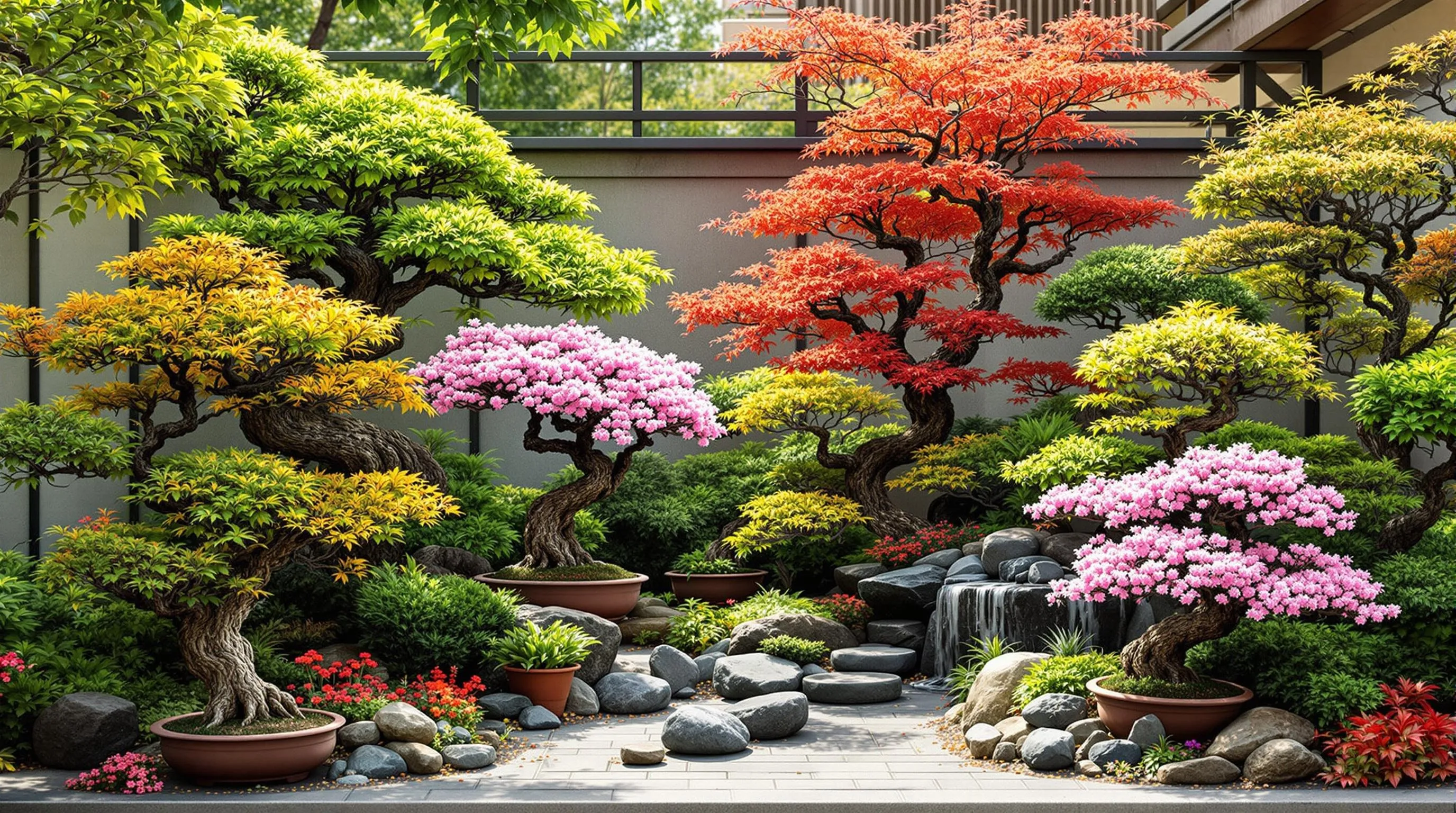
A well-planned bonsai garden showcases beauty throughout all seasons with thoughtful arrangements that highlight each tree’s changing characteristics. Create distinct seasonal vignettes by grouping deciduous bonsai trees that display vibrant autumn colors together, while positioning evergreens as year-round anchors. In spring, feature flowering varieties like azalea and cherry bonsai front and center to celebrate their blooms. During summer, emphasize tropical species and those with lush foliage, arranging them where afternoon shade protects delicate leaves. For winter interest, showcase conifers and trees with interesting bark or branch structures when other specimens are dormant. Carry out a rotation system to move trees in and out of prominent display positions as they reach peak seasonal beauty. This approach ensures your bonsai garden remains visually captivating regardless of the season, creating an ever-changing living artwork that celebrates nature’s cycles while maintaining continuous visual harmony.
Mixing Bonsai Varieties for a Dynamic Garden Composition
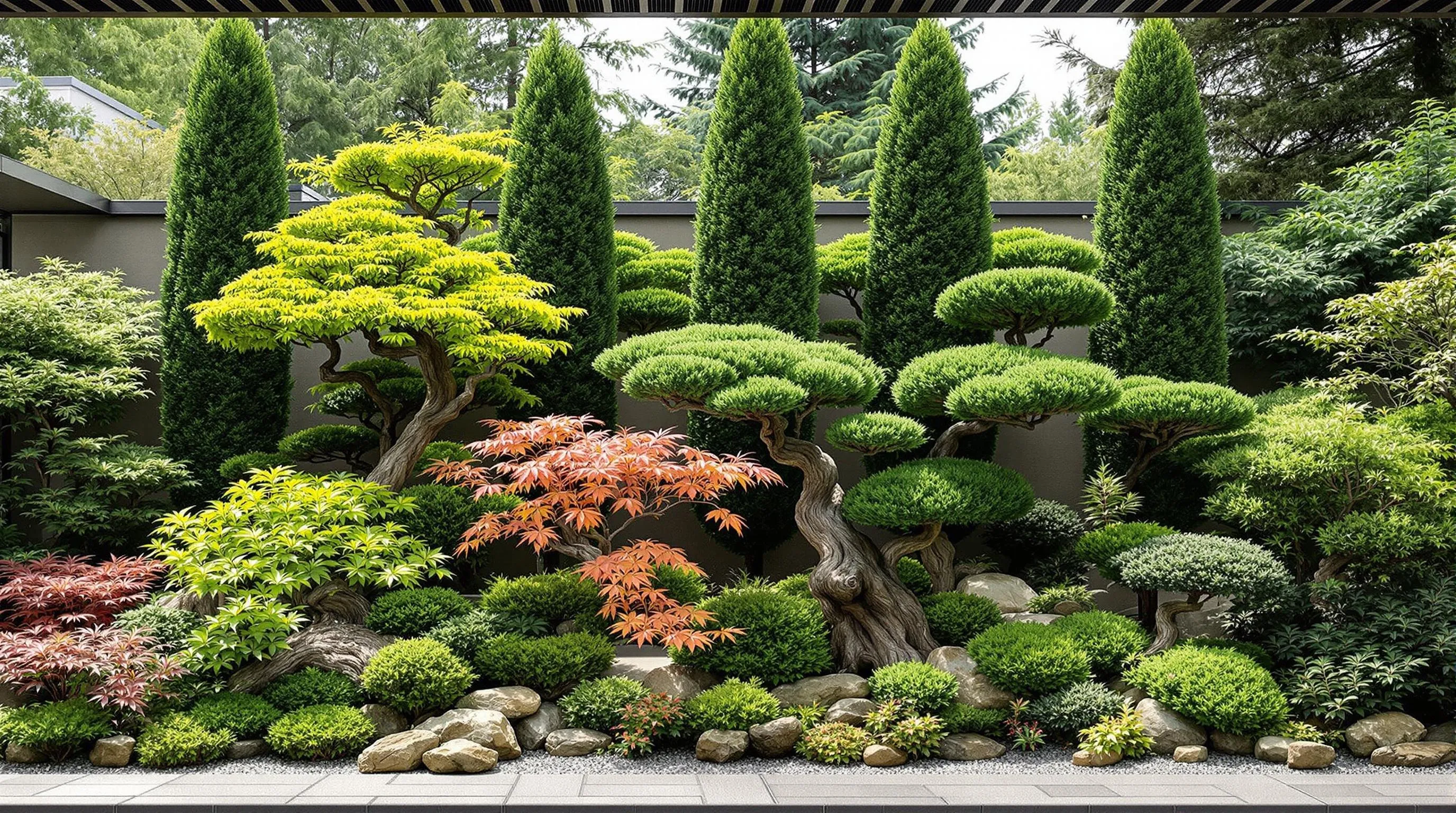
Creating a visually captivating bonsai garden requires thoughtful integration of different varieties to achieve balance and visual interest. By combining various bonsai types, you’ll create a miniature industry that captures attention and tells a compelling story through contrasting elements.
Complementary Size and Shape Combinations
Mix bonsai trees of different heights and silhouettes to create depth and dimension in your garden display. Pair tall, upright styles like formal upright (Chokkan) with cascading (Kengai) varieties that spill downward dramatically. Position larger specimens at the back of your display with smaller ones in front to create a natural perspective. The interplay between a majestic Juniper with its strong vertical presence and a delicate maple with its spreading canopy creates striking visual tension. For maximum impact, combine at least three different sizes: tall background trees (24-36 inches), medium middle-ground specimens (12-18 inches), and small accent plants (4-8 inches). This graduated arrangement mimics natural forest compositions while maximizing your viewing pleasure from multiple angles.
Blending Different Tree Species Effectively
Combine deciduous and evergreen species to ensure your garden maintains visual interest throughout all seasons. Pair Japanese maples with their vibrant seasonal changes alongside steadfast junipers that provide consistent structure year-round. When selecting species combinations, consider their growth rates and maintenance needs—group trees with similar watering requirements together for practical care. Create thematic collections based on native geography, such as pairing Chinese elms with Chinese junipers, or contrast leaf textures by placing fine-needled pines near broad-leafed ficus trees. For a cohesive yet diverse collection, limit your palette to 3-5 primary species with complementary characteristics. This thoughtful mixing of species not only enhances the aesthetic appeal but also showcases the rich diversity of the bonsai tradition while creating a ever-changing garden that evolves with each passing season.
Practical Storage Solutions for Bonsai Tools and Supplies
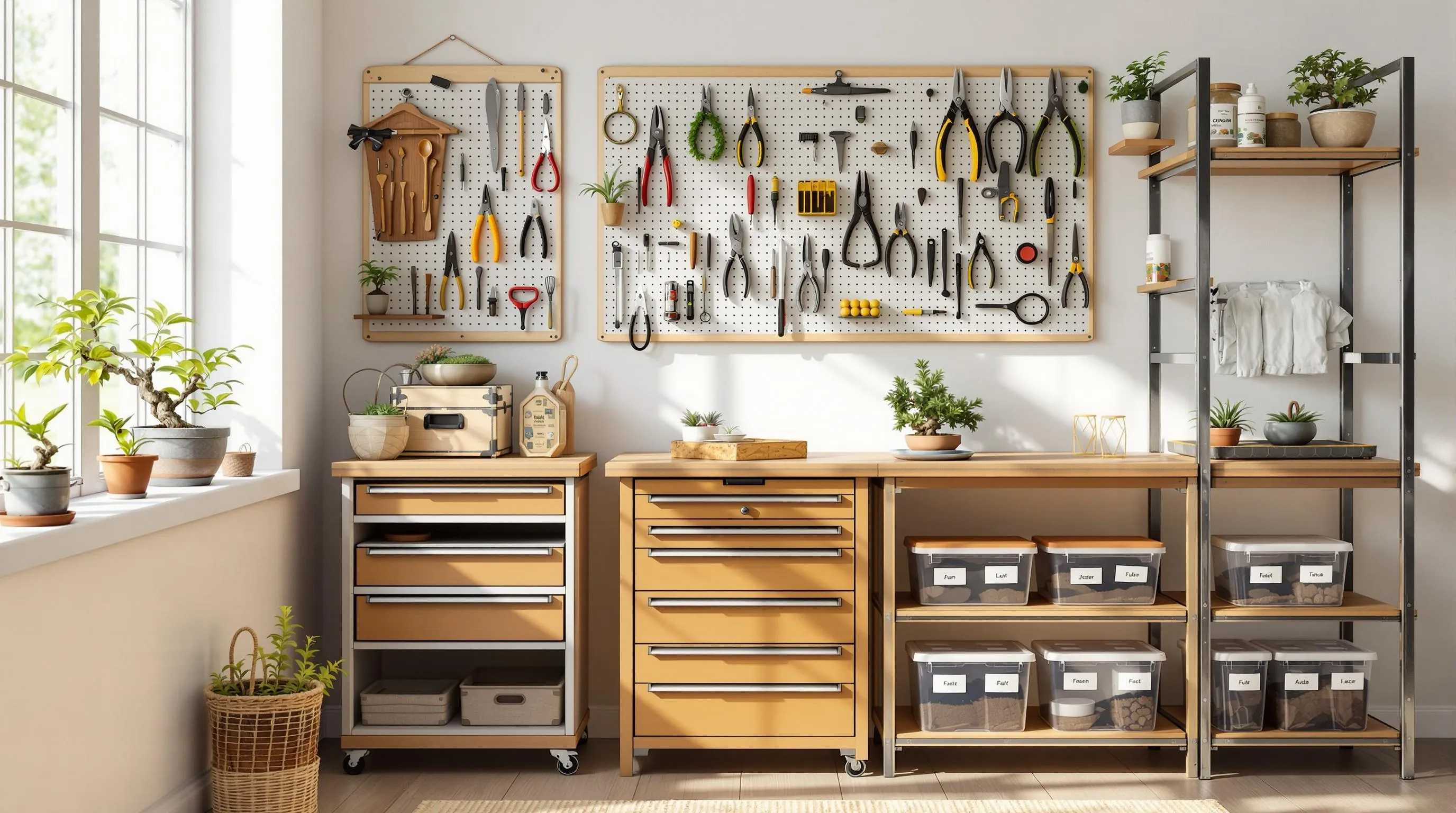
Organizing your bonsai tools and supplies is essential for maintaining an efficient and enjoyable bonsai practice. A well-designed storage system saves time, preserves your equipment, and creates a more harmonious garden environment. Consider installing a compact tool cabinet with adjustable shelving near your work area, allowing quick access to frequently used items like pruning shears, wire cutters, and concave cutters. Wall-mounted pegboards offer versatile storage options, keeping tools visible and preventing misplacement. For soil components and fertilizers, use clear, labeled containers stacked on sturdy shelving units. Dedicated drawers with custom inserts can protect your delicate tools from damage, while portable tool caddies make maintenance sessions more efficient as you move throughout your garden. Seasonal supplies should be organized separately—perhaps in stackable bins—to prevent clutter during off-seasons. By creating designated homes for all your bonsai essentials, you’ll transform maintenance from a chore into a smooth, meditative ritual that enhances your connection with your miniature landscapes.
Budget-Friendly DIY Bonsai Garden Ideas for Beginners
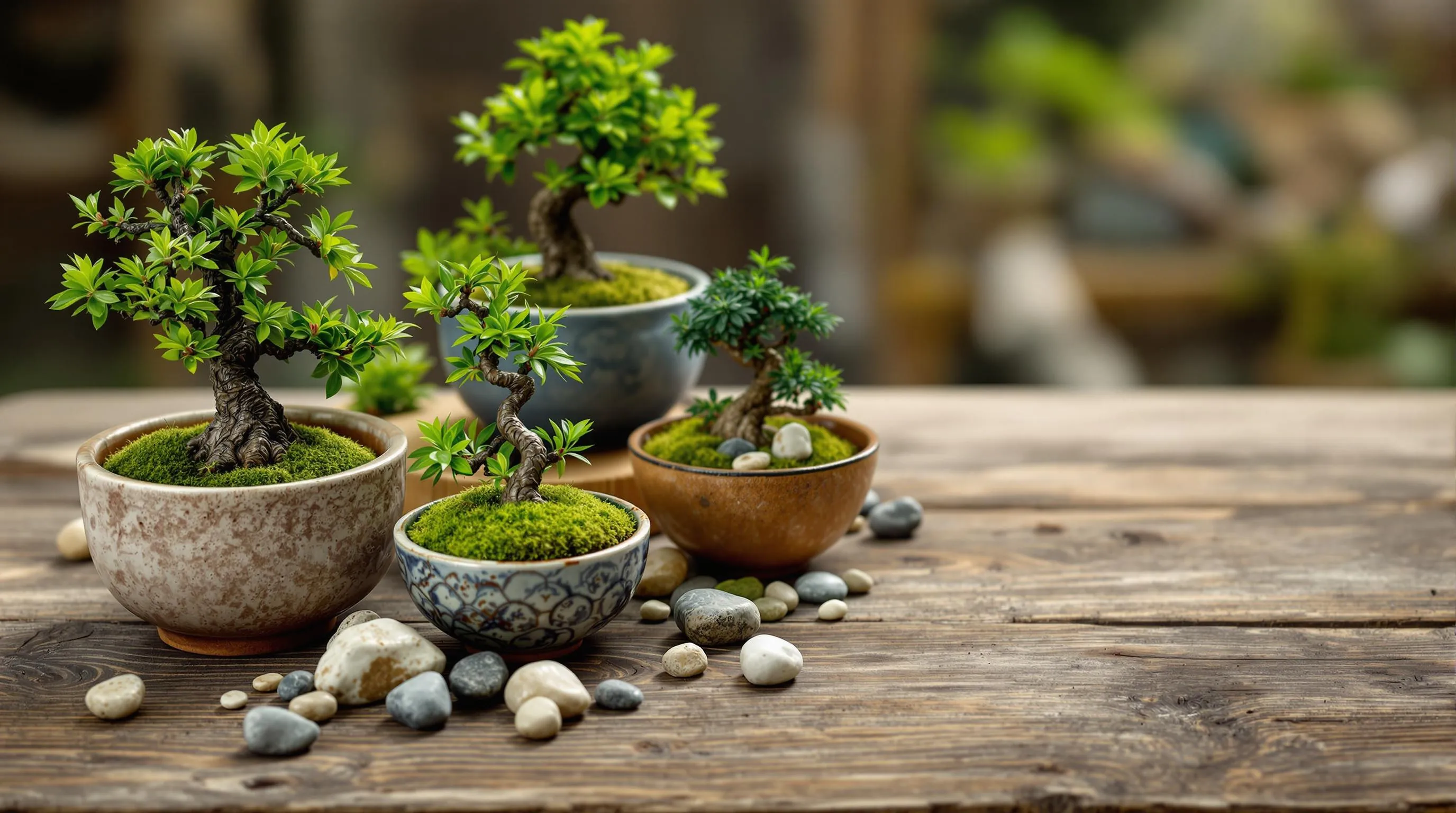
Creating a bonsai garden doesn’t have to drain your wallet. You can start your bonsai journey with these cost-effective approaches that deliver impressive results. Begin by propagating plants from cuttings or seeds—many common houseplants like jade, ficus, and juniper make excellent bonsai subjects when properly trained. Repurpose everyday containers like ceramic bowls, shallow terracotta pots, or even vintage teacups as unique bonsai vessels after drilling drainage holes. Create your own bonsai soil mix by combining regular potting soil with perlite and coarse sand at a fraction of specialty soil costs. For tools, start with basic household implements like kitchen scissors and tweezers before investing in specialized equipment. Collect natural decorative elements like small rocks, moss, and driftwood during outdoor walks to enhance your display. Join online bonsai communities where beginners often exchange cuttings and share resources. Remember that patience is free—developing a bonsai garden takes time, but watching your miniature industry evolve offers rewards well beyond the initial investment.
Enhancing Your Bonsai Garden with Complementary Plant Companions
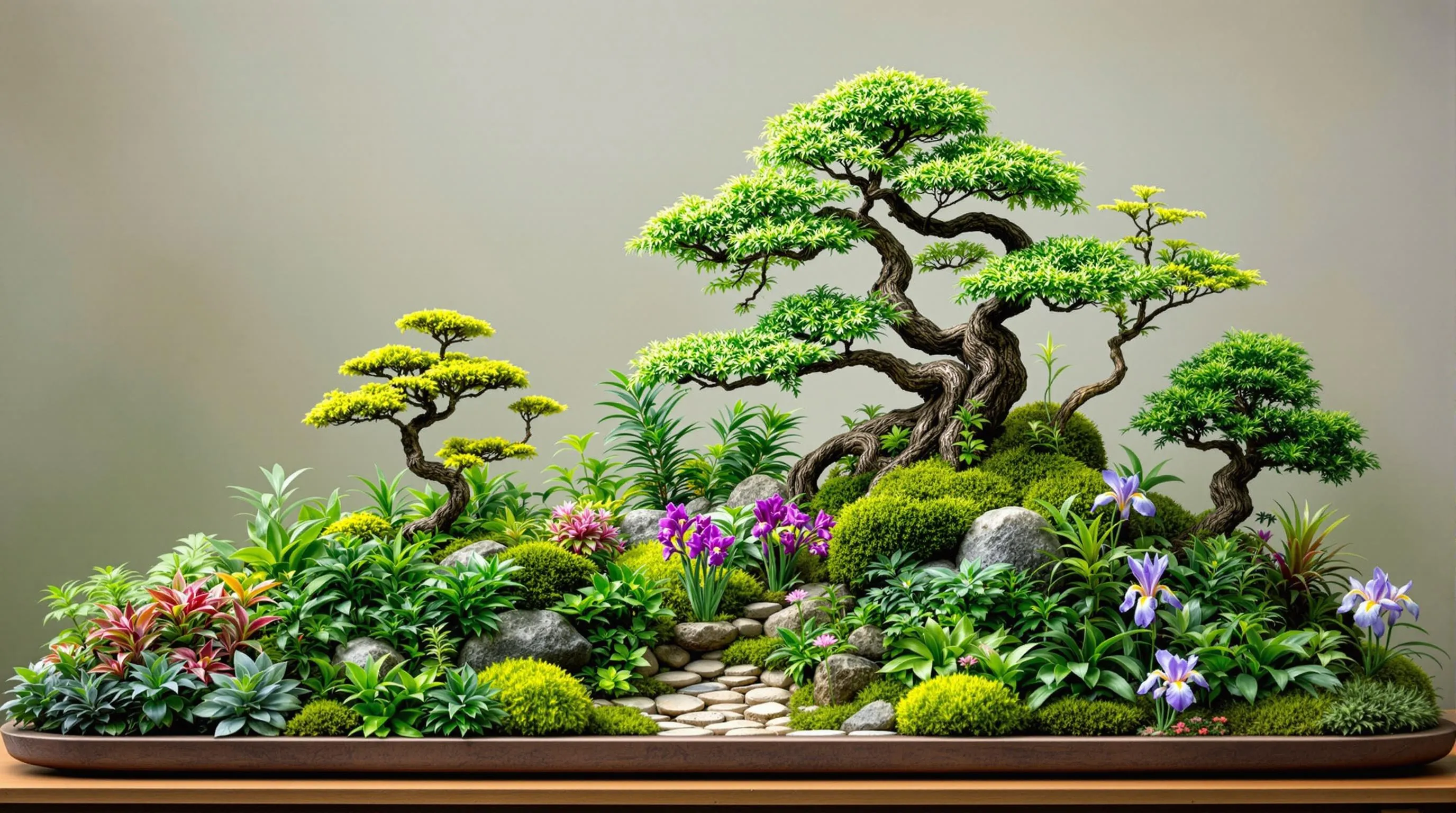
Your bonsai garden can become even more visually striking with the right companion plants. Complementary species create depth, texture, and seasonal interest that highlight your miniature trees’ beauty. Consider adding small-leaved groundcovers like Irish moss or baby tears to create a lush forest floor effect beneath your bonsai. Miniature ferns add delicate texture while tiny flowering plants such as violets or dwarf irises provide seasonal color bursts without overwhelming your bonsai specimens. Arrange accent plants at varying heights to direct visual flow throughout your display, placing smaller companions closer to viewing areas and taller plants toward the back. Remember to select companions with similar water and light requirements to your bonsai trees for easier maintenance. These thoughtful pairings not only enhance the aesthetic appeal of your bonsai collection but also create a more complete, natural-looking industry that evokes the feeling of a mature forest in miniature form.
Transforming Small Spaces into Spectacular Bonsai Gardens
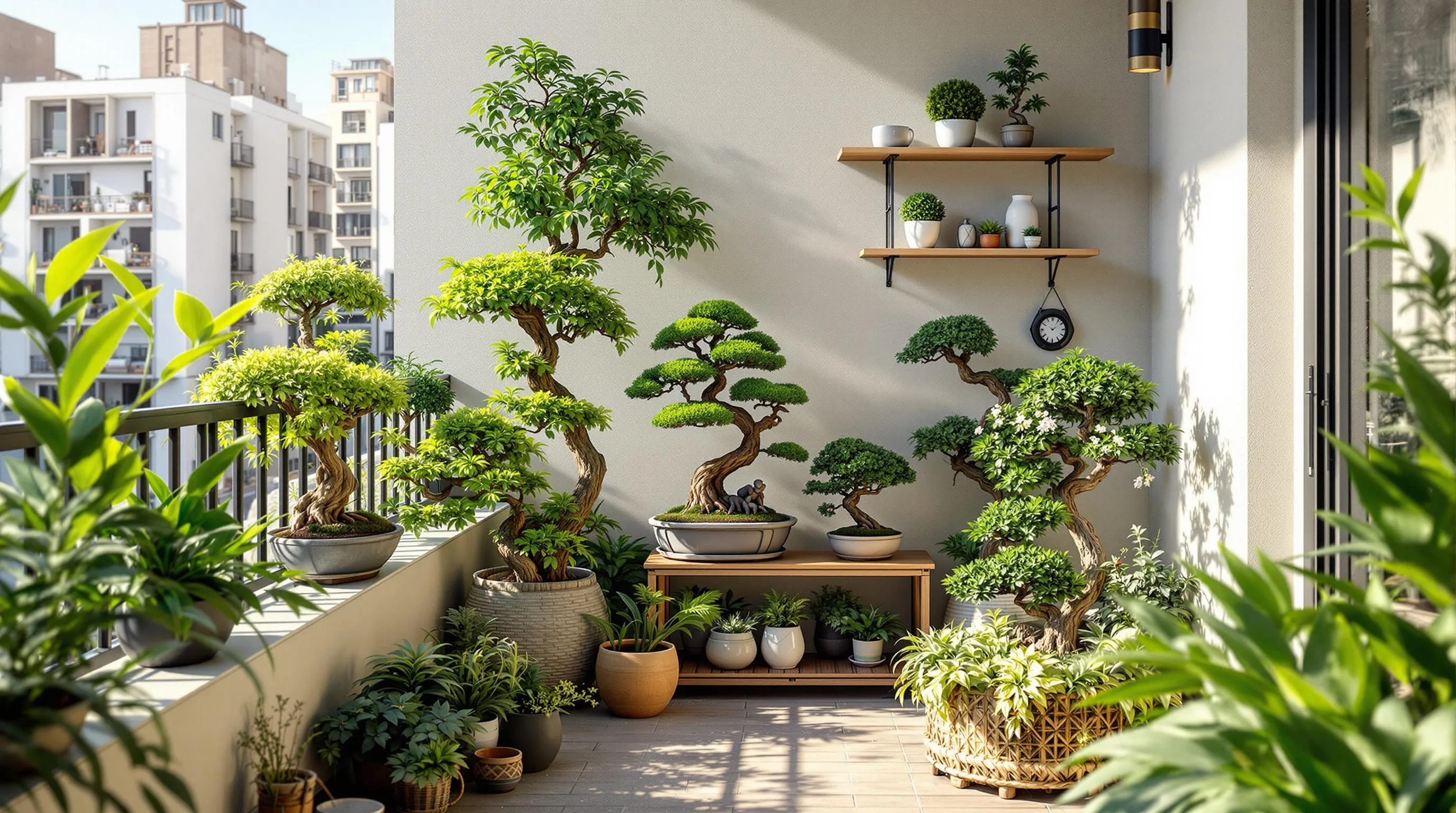
You don’t need a sprawling yard to create a magnificent bonsai display. Even the smallest spaces—balconies, windowsills, or tiny apartment corners—can be transformed into breathtaking bonsai gardens with thoughtful planning. Start by assessing your microclimate, noting light patterns and temperature fluctuations throughout the day. Choose species that thrive in your exact conditions; jade plants and ficus varieties excel in indoor settings while junipers and pines work well for small outdoor spaces. Create visual interest through vertical displays using wall-mounted shelves or tiered stands that maximize limited square footage. Consider using mirrors strategically to amplify light and create the illusion of greater space. Group bonsai trees of varying heights and textures to create depth, and incorporate small accent plants for seasonal interest. Remember that small spaces actually highlight the miniature beauty of bonsai, making them perfect showcases for these living artworks. With careful selection and arrangement, your compact bonsai garden can become an impressive focal point that brings nature’s serenity into even the most limited living environments.
Conclusion: Bringing Your Bonsai Garden Vision to Life
Your bonsai garden journey offers endless possibilities for creative expression and mindful practice. Whether you’re designing a grand outdoor display or maximizing a tiny windowsill these miniature landscapes bring profound joy and tranquility to any space.
Remember that bonsai gardening is both an art form and a lifelong pursuit. Start with what inspires you and allow your garden to evolve naturally over time. With thoughtful planning seasonal rotations and complementary elements you’ll create a living masterpiece that reflects your unique aesthetic vision.
The true reward of bonsai gardening extends beyond beautiful trees to the meditative practice patience and connection with nature it fosters in your daily life. Now it’s time to transform your inspiration into reality and watch your bonsai sanctuary flourish.







